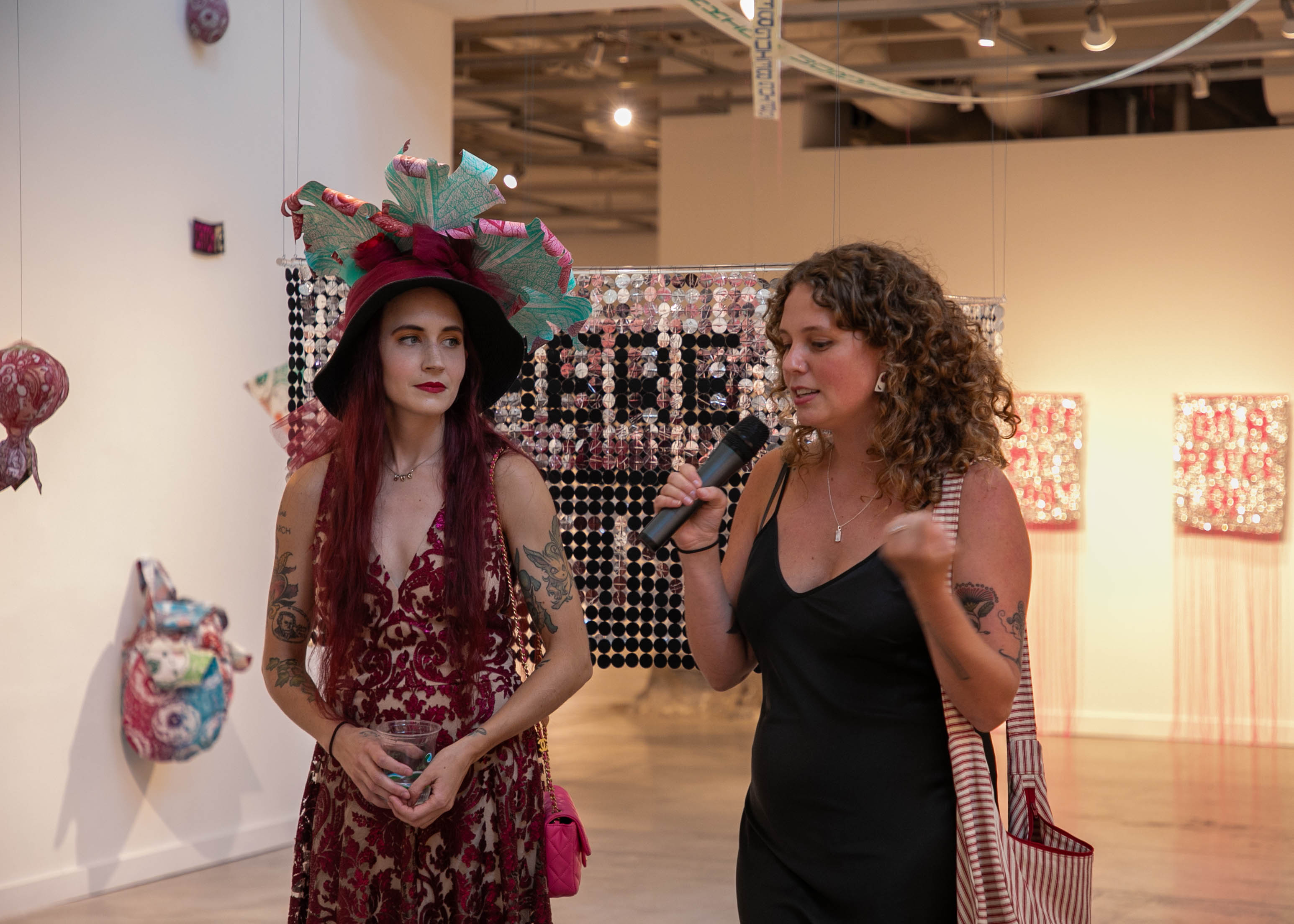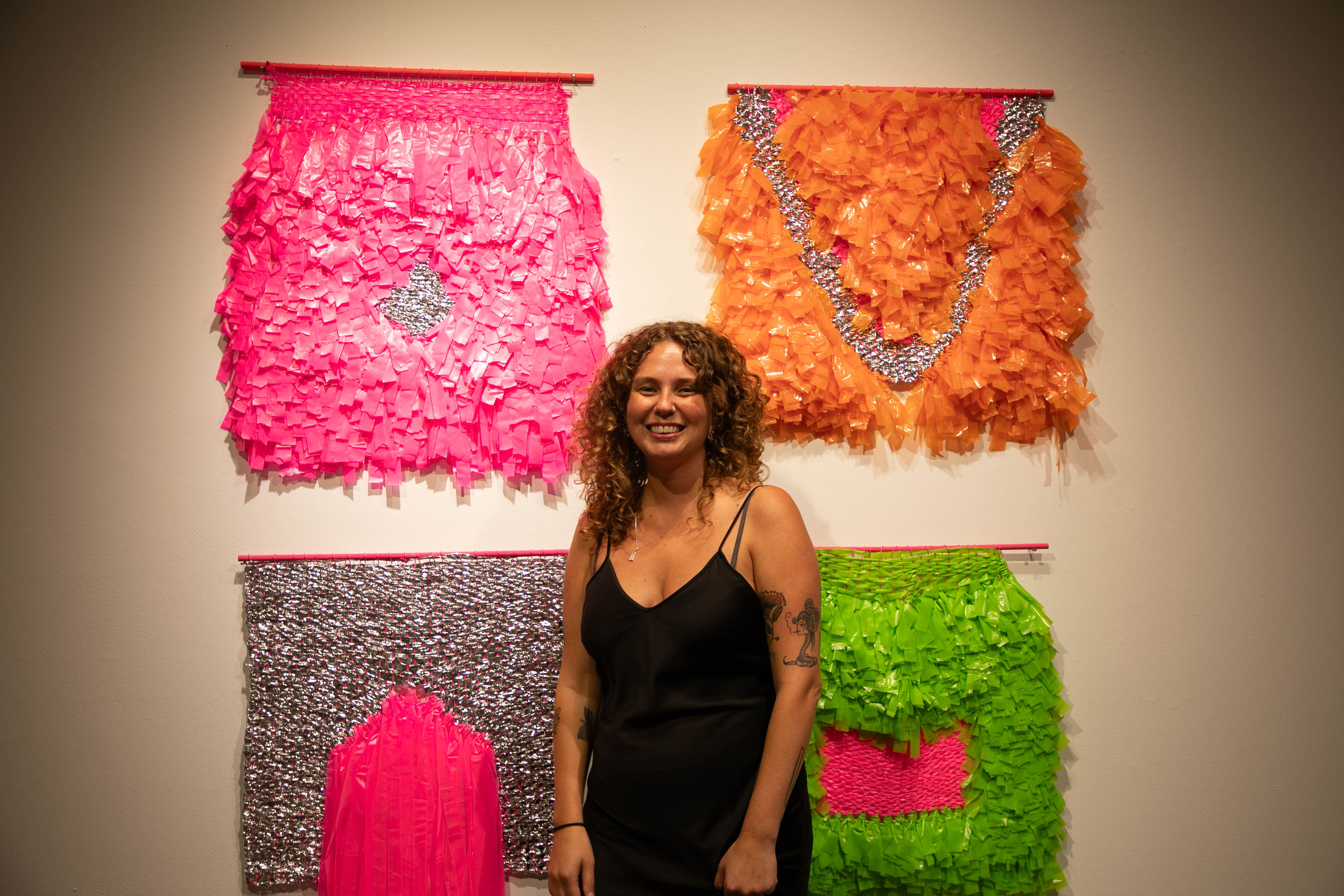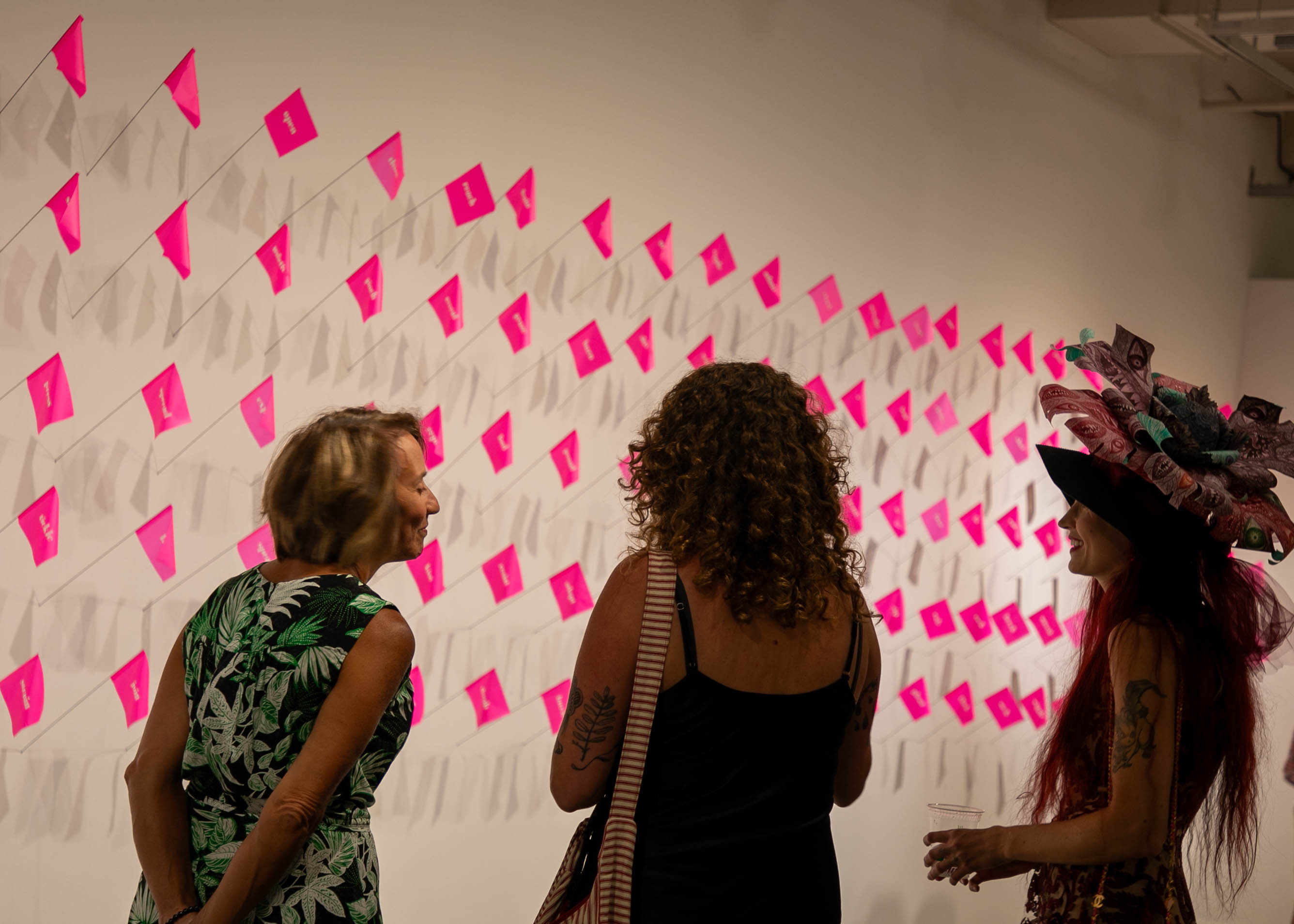Women’s Work: An Interview with Alex McClay and Stephanie Berrie

Women’s Work reimagines the inherent meaning of femininity and power. Reclaiming the disparaging term, artists Alex McClay and Stephanie Berrie present the dichotomy of existing within womanhood and femininity in a traditionally oppressive world. Through the use of media such as beaded tapestries and weavings from McClay and Berrie’s printmaking work, the collaborative exhibition represents a reclamation of power and strength. Visitors experience the presentation of feminism in the worlds of Berrie’s naturalistic motifs and McClay’s neon domain of visceral texts and metallic forms.
Women’s Work is on view in the lower gallery of Urban Arts Space in downtown Columbus from August 20 through September 21.

Stephanie, your work deals with the reclamation of power and expressing vulnerability in a world where femininity is forced to be repurposed. How did you find the balance between softness and strength?
Stephanie Berrie: I think strength comes from one’s ability to be able to exude confidence, vulnerability, and compassion without being overbearing or too forthright. There are many ways to think of strength—whether that’s physical strength, courage, the strength to face your own personal fears and obstacles, or the strength to stand up for yourself and for those you love. I don’t think softness needs to be compromised or is separate from those things. In fact, I think there’s a power in softness that we don’t typically associate with strength, and it comes through in being compassionate, forgiving, and understanding to ourselves and others. You don’t have to pretend to be impenetrable in order to be perceived as strong; being able to be vulnerable and to connect with others shows strength in innumerable ways.
Alex, text is used frequently within your works. What do you wish to show and tell audiences coming to see the exhibition?
Alex McClay: The text in my work is often ambiguous and poetic, offering glimpses of vulnerability, honesty, and femininity. They often refer to past experiences of trauma—of the thoughts, feelings, and words that occur after boundaries are crossed and proved to be permeable. The text is also ubiquitous. My hope is that the viewer can see themselves in the text and create their own story, or have their own memory, with that text in it. This gives the viewer a personal pathway into the work.
If you had to choose a new medium to work with in a future show, what would it be and why?
SB: For a future show, I would like to experiment more with the technique of eco printing/dyeing, where you take natural materials such as plants, leaves, sticks, rust, etc. and make dyes and prints with them. It’s a technique that yields such beautiful and painterly textures and patterns, so I think it would be interesting to incorporate my etchings, screen prints, and lithographs with those textures. It would also have a more direct tie to nature, so I think it would be good to incorporate actual plants and plant textures with the ones I draw into my copper plates and screens.

Some of your works deal with a sense of uniformity. What artistic elements did you want to emphasize, and which do you hope resonate with visitors?
AM: There is a lot of repetition in my work. The textile techniques that I use, like weaving and beading, often call for that. To me, these repeated forms are like pixels and can be arranged to communicate like the pixels on our phones and computer screens. For viewers, this uniformity can often bring a sense of calmness, which can be interrupted when the viewer takes a closer look or reads the text that is embedded in the works. My hope is that the viewer feels rewarded when they are willing to take time to take a closer look at the work.
What perception of “Women’s Work” do you hope audiences take away after seeing the show?
SB: I hope that people take away a sense of empowerment and vulnerability after experiencing the work, but I also hope people feel a sense of wonder and escapism from the show too. Some of the works are confrontational and some of them are meant to take you into a different world. There’s a play between reality and make-believe in the show, between facing tough challenges and finding respite from those challenges, and I think the work reflects that from Alex’s weavings and flags to the playful colors and forms from the installation. There is beauty to be found from our lowest and darkest moments, and I think the work displays that.
How has working on this show altered your view of yourself, your identity, or how you approach your art form?
AM: Working on this show with Stephanie has been an amazing experience. When we conceived of the concept for the show, I felt frustrated that sometimes the work that I made wasn’t taken seriously by artists, curators, and critics that preferred more traditional forms of art making. This show allowed me to honor and elevate the textile work that I love to make.

Women’s Work is a collaborative project that exists throughout the lower gallery. How was it working together and interacting with the layout of the gallery space?
SB: It was great working with Alex; I think we work really well together. We have different art styles and ways of making things, so what I lack as far as composition and design, Alex makes up for it since she has a very strong sense of design, color, and detail. We find a way to balance each other’s work; for example, I’m definitely a maximalist and want to add more and more into the space, where Alex helps calm me down and helps me think about spacing and how some pieces would obstruct others and so on. So it’s a great balance we have collaboratively, which is why I think Women’s Work is so successful. Prior to install, we met and set out a skeletal layout of the pieces, indicating where we wanted the installation versus the more traditional wall hanging works and video. While creating the installation, we set it up as we went in the space, bouncing ideas and placements off of each other.
AM: I love working with Stephanie. We share a studio together and have worked together for a few years now. I think we have a perfectly balanced set of strengths and weaknesses, and I am so grateful to have a working partner like her! Putting the show together, although a little stressful, came together very gracefully and naturally. We both have experience installing our own work, so we were able to rely on our previous experience to make this show successful. We printed out the floor plan to make a general layout of the exhibition before we got to the space and as we were planning what to make for the show. Then, when we got there, we walked through the gallery together and talked about where we thought certain pieces should go. Finally, we laid everything out so we could visualize it. We were able to edit and hang work from there. I am so grateful for the opportunity to work with Stephanie on this project. It was so much fun.

Materiality is significant in communicating intention and messaging throughout the show. How did you each determine what material to use when and for which pieces? In terms of your respective pieces, what did one specific medium mean to you throughout the creative process?
AM: I love experimenting with new materials, using unexpected materials, and making my own materials. For example, some of the tapestries in the show are made from 3D printed beads that I printed. I love being able to design the color, shape, and size of the beads. Some of the other work in this show is made from materials like emergency blanket, survey tape, and survey flags. Emergency blankets, otherwise known as safety blankets, were originally developed by NASA to protect their rockets, rovers, and satellites from the extreme temperatures in outer space. Since then, it has become a staple for any hiker or marathon runner and can be found in most first-aid kits or car trunks. For the average human, the practical application for this material is to stay warm and signal for help in emergency situations. In my work, however, the blankets represent a symbolic means to an end, a protective layer, and an emblem of survival.
In the collection of wearable works titled If Only//You Had//Listened, I cut the blanket into small three-eighths-inch circles using a laser cutter and pieced it back together by hand on a grid of thread. In its original form, the blanket is strong and reliable. When deconstructed, I render it permeable and fragile. Fragmented and pixelated text was then embedded in the material as it was reconstructed at intersections of strength and stress.
SB: I love using paper and fabric in my work. I think paper is such a good material to exhibit both strength and softness—it can withstand so much pressure when being printed; can hold shape and structure; but it also can tear, burn, and wrinkle so easily. I love materials that are both strong and fragile; I think it gives more complexity and tension to the work. Fabric relates in the same way for me, but it has a little more malleability than paper. I like making pieces such as the big wall flowers that look so big and colorful and domineering, but they can be easily ruined if someone steps on them or if they fall off the wall. It creates a tension between ephemerality and permanence in the work.


